Effect of learner autonomy on English proficiency of non-English major students
Learner autonomy (LA) has been considered to be one
of the important goals in education. This article investigates the effect
of LA on English proficiency (EP) of non-English major students. 635
Vietnamese students from five member universities of the University
of Danang completed the questionnaire on LA. The collected data
was compared with the scores of their English language course. The
results show that there are overall positive and significant
correlations between LA and their EP. However, while there are
significant correlations between LA and EP among high proficiency
learners, such correlations do not exist among low proficiency
learners. The results also indicate that LA can predict students’ EP.
The study suggests that students should be aware of the importance
of LA and empowered to take charge of their own learning process
to enhance their language proficiency. Also, LA may be used by
university administrators to predict learners’ academic potential.
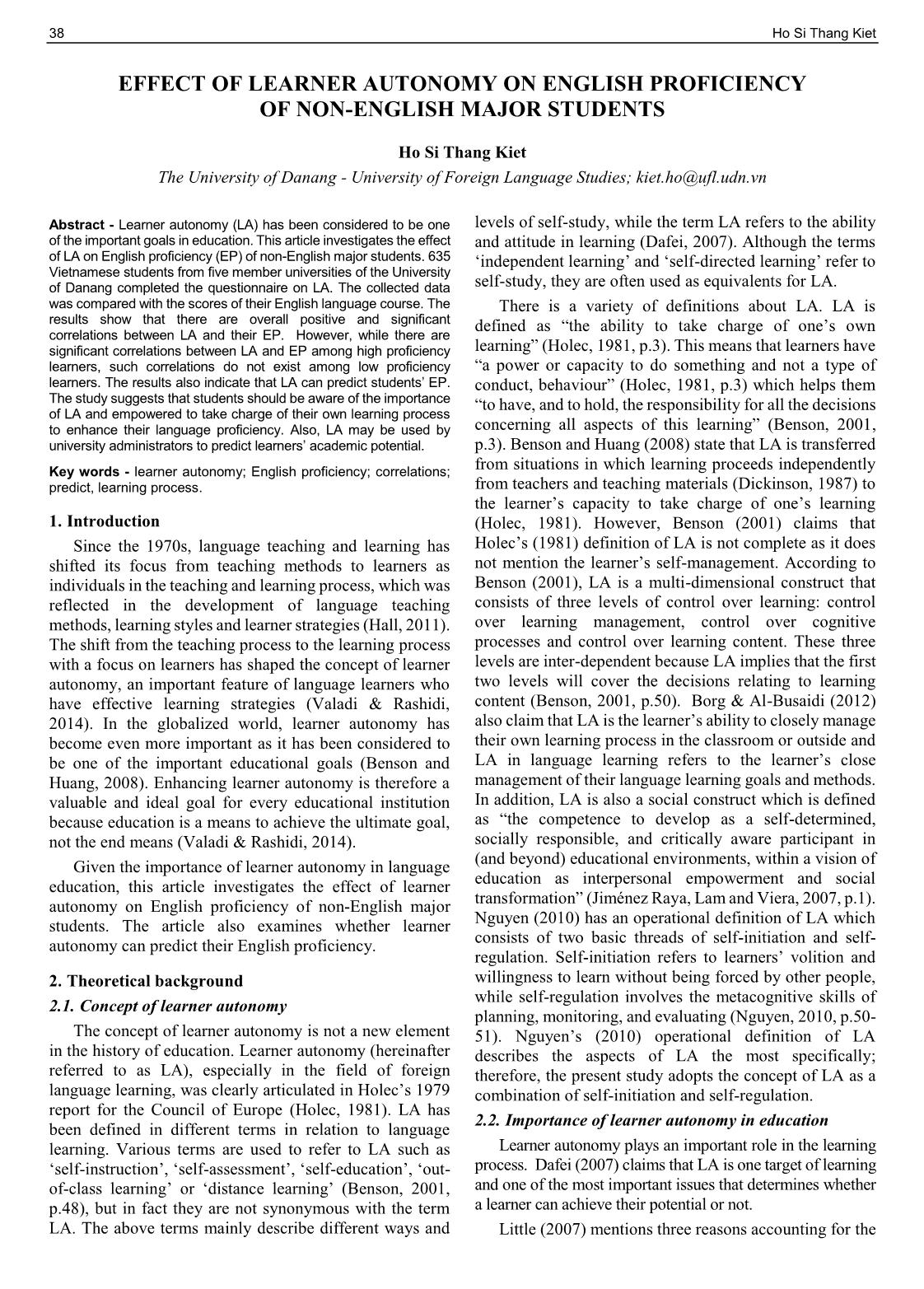
Trang 1
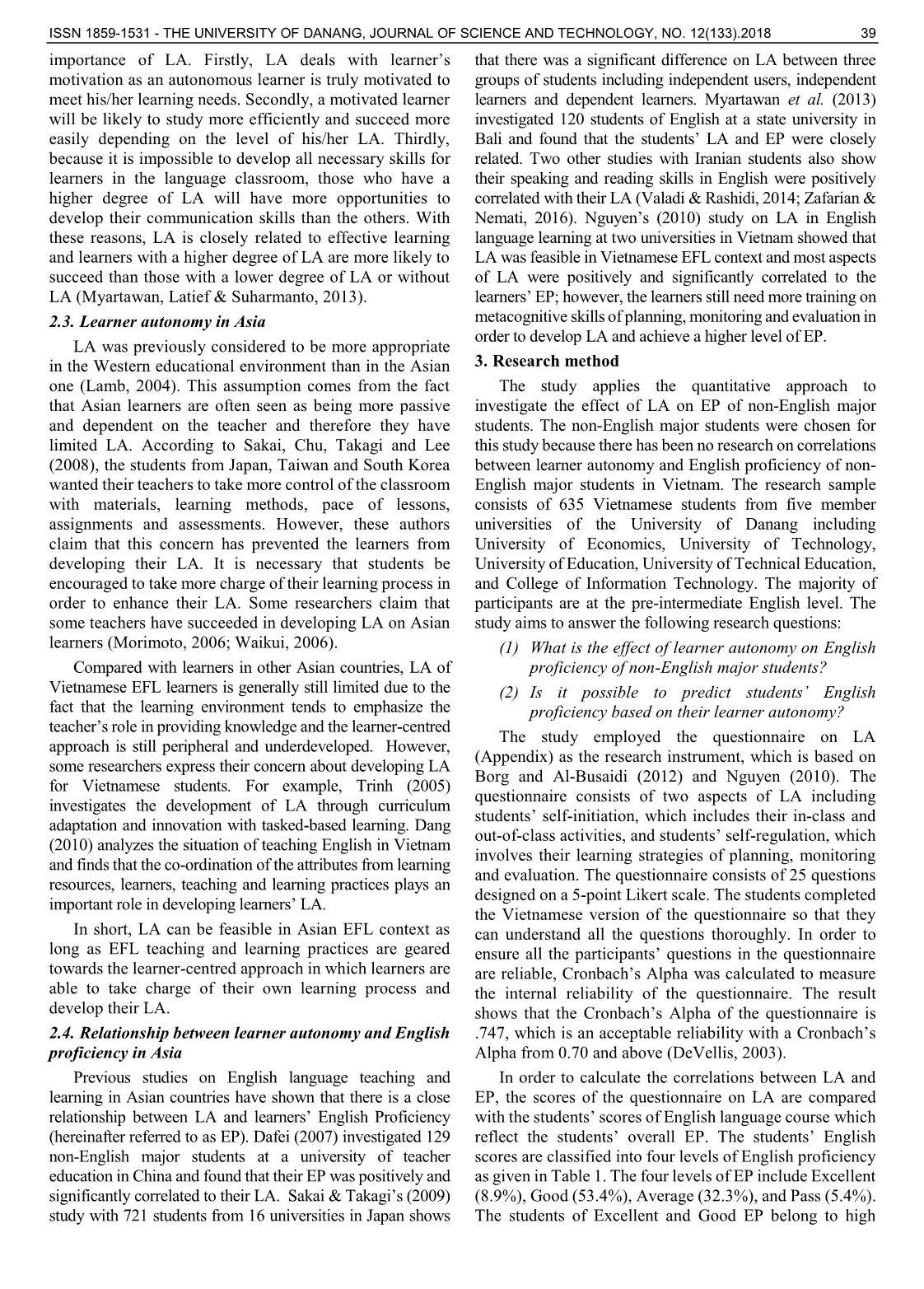
Trang 2
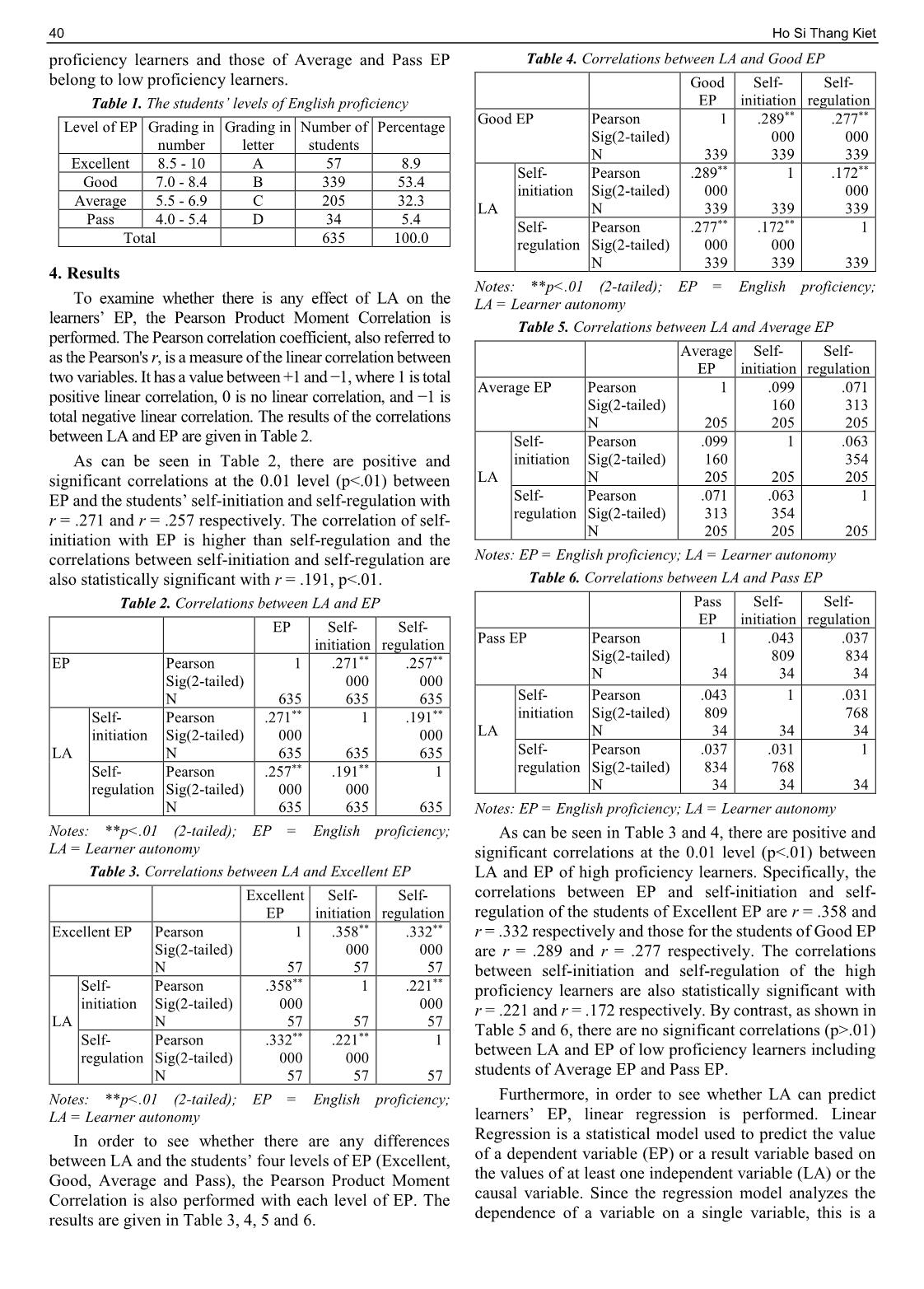
Trang 3
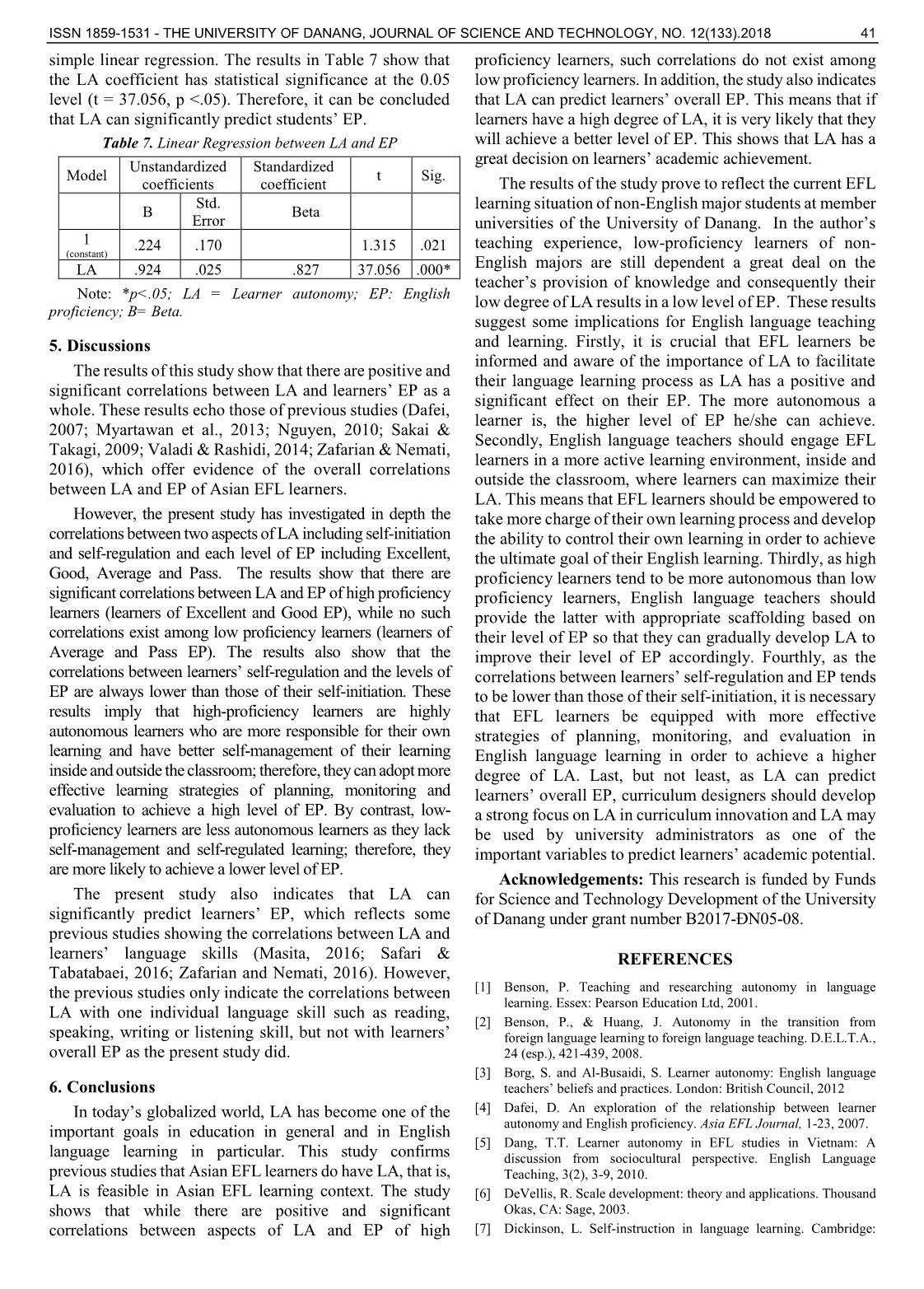
Trang 4
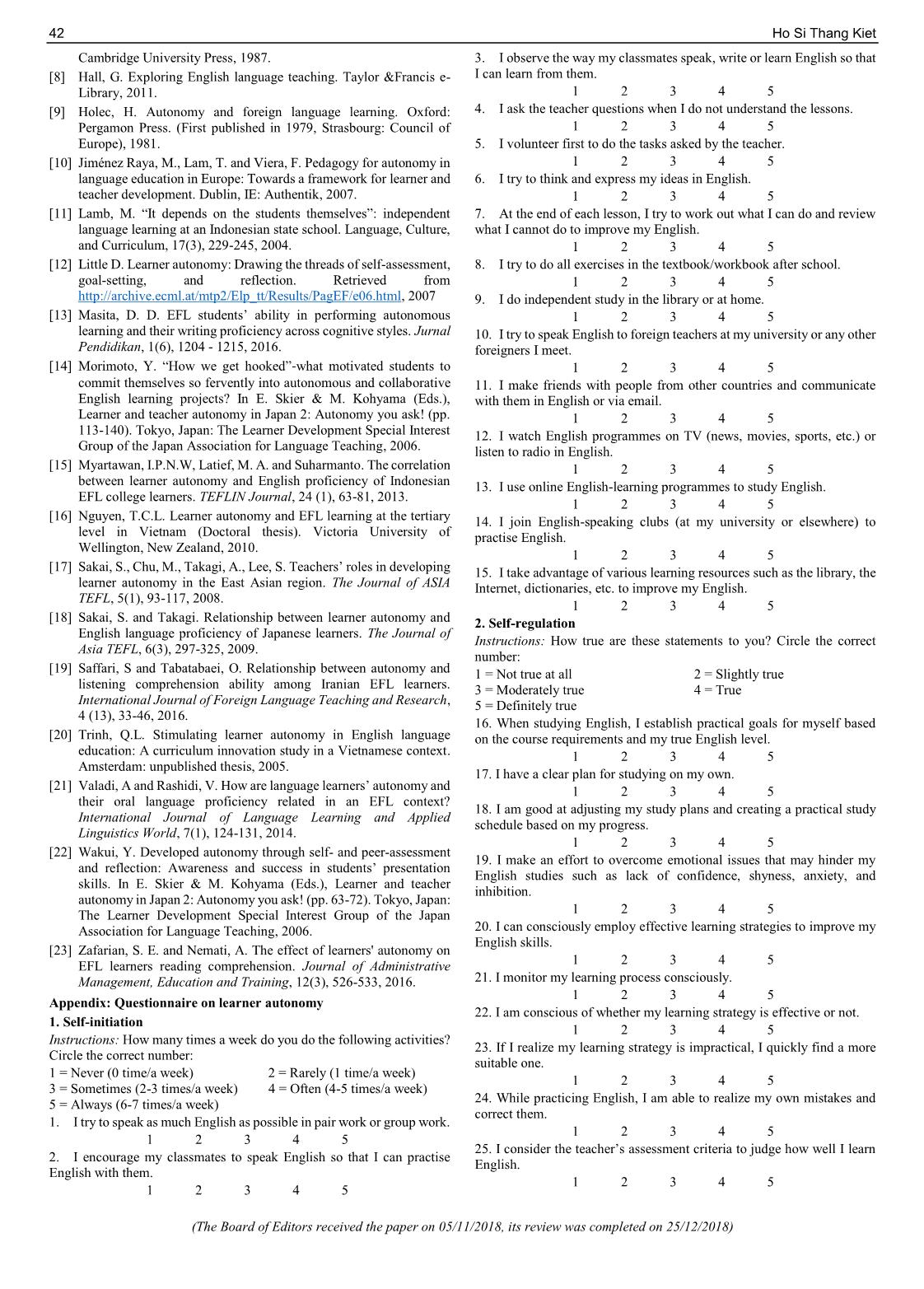
Trang 5
Tóm tắt nội dung tài liệu: Effect of learner autonomy on English proficiency of non-English major students
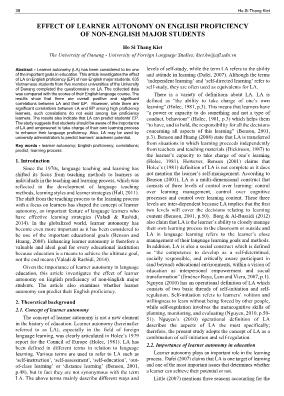
iation Self- regulation Average EP Pearson Sig(2-tailed) N 1 205 .099 160 205 .071 313 205 LA Self- initiation Pearson Sig(2-tailed) N .099 160 205 1 205 .063 354 205 Self- regulation Pearson Sig(2-tailed) N .071 313 205 .063 354 205 1 205 Notes: EP = English proficiency; LA = Learner autonomy Table 6. Correlations between LA and Pass EP Pass EP Self- initiation Self- regulation Pass EP Pearson Sig(2-tailed) N 1 34 .043 809 34 .037 834 34 LA Self- initiation Pearson Sig(2-tailed) N .043 809 34 1 34 .031 768 34 Self- regulation Pearson Sig(2-tailed) N .037 834 34 .031 768 34 1 34 Notes: EP = English proficiency; LA = Learner autonomy As can be seen in Table 3 and 4, there are positive and significant correlations at the 0.01 level (p<.01) between LA and EP of high proficiency learners. Specifically, the correlations between EP and self-initiation and self- regulation of the students of Excellent EP are r = .358 and r = .332 respectively and those for the students of Good EP are r = .289 and r = .277 respectively. The correlations between self-initiation and self-regulation of the high proficiency learners are also statistically significant with r = .221 and r = .172 respectively. By contrast, as shown in Table 5 and 6, there are no significant correlations (p>.01) between LA and EP of low proficiency learners including students of Average EP and Pass EP. Furthermore, in order to see whether LA can predict learners’ EP, linear regression is performed. Linear Regression is a statistical model used to predict the value of a dependent variable (EP) or a result variable based on the values of at least one independent variable (LA) or the causal variable. Since the regression model analyzes the dependence of a variable on a single variable, this is a ISSN 1859-1531 - THE UNIVERSITY OF DANANG, JOURNAL OF SCIENCE AND TECHNOLOGY, NO. 12(133).2018 41 simple linear regression. The results in Table 7 show that the LA coefficient has statistical significance at the 0.05 level (t = 37.056, p <.05). Therefore, it can be concluded that LA can significantly predict students’ EP. Table 7. Linear Regression between LA and EP Model Unstandardized coefficients Standardized coefficient t Sig. B Std. Error Beta 1 (constant) .224 .170 1.315 .021 LA .924 .025 .827 37.056 .000* Note: *p<.05; LA = Learner autonomy; EP: English proficiency; B= Beta. 5. Discussions The results of this study show that there are positive and significant correlations between LA and learners’ EP as a whole. These results echo those of previous studies (Dafei, 2007; Myartawan et al., 2013; Nguyen, 2010; Sakai & Takagi, 2009; Valadi & Rashidi, 2014; Zafarian & Nemati, 2016), which offer evidence of the overall correlations between LA and EP of Asian EFL learners. However, the present study has investigated in depth the correlations between two aspects of LA including self-initiation and self-regulation and each level of EP including Excellent, Good, Average and Pass. The results show that there are significant correlations between LA and EP of high proficiency learners (learners of Excellent and Good EP), while no such correlations exist among low proficiency learners (learners of Average and Pass EP). The results also show that the correlations between learners’ self-regulation and the levels of EP are always lower than those of their self-initiation. These results imply that high-proficiency learners are highly autonomous learners who are more responsible for their own learning and have better self-management of their learning inside and outside the classroom; therefore, they can adopt more effective learning strategies of planning, monitoring and evaluation to achieve a high level of EP. By contrast, low- proficiency learners are less autonomous learners as they lack self-management and self-regulated learning; therefore, they are more likely to achieve a lower level of EP. The present study also indicates that LA can significantly predict learners’ EP, which reflects some previous studies showing the correlations between LA and learners’ language skills (Masita, 2016; Safari & Tabatabaei, 2016; Zafarian and Nemati, 2016). However, the previous studies only indicate the correlations between LA with one individual language skill such as reading, speaking, writing or listening skill, but not with learners’ overall EP as the present study did. 6. Conclusions In today’s globalized world, LA has become one of the important goals in education in general and in English language learning in particular. This study confirms previous studies that Asian EFL learners do have LA, that is, LA is feasible in Asian EFL learning context. The study shows that while there are positive and significant correlations between aspects of LA and EP of high proficiency learners, such correlations do not exist among low proficiency learners. In addition, the study also indicates that LA can predict learners’ overall EP. This means that if learners have a high degree of LA, it is very likely that they will achieve a better level of EP. This shows that LA has a great decision on learners’ academic achievement. The results of the study prove to reflect the current EFL learning situation of non-English major students at member universities of the University of Danang. In the author’s teaching experience, low-proficiency learners of non- English majors are still dependent a great deal on the teacher’s provision of knowledge and consequently their low degree of LA results in a low level of EP. These results suggest some implications for English language teaching and learning. Firstly, it is crucial that EFL learners be informed and aware of the importance of LA to facilitate their language learning process as LA has a positive and significant effect on their EP. The more autonomous a learner is, the higher level of EP he/she can achieve. Secondly, English language teachers should engage EFL learners in a more active learning environment, inside and outside the classroom, where learners can maximize their LA. This means that EFL learners should be empowered to take more charge of their own learning process and develop the ability to control their own learning in order to achieve the ultimate goal of their English learning. Thirdly, as high proficiency learners tend to be more autonomous than low proficiency learners, English language teachers should provide the latter with appropriate scaffolding based on their level of EP so that they can gradually develop LA to improve their level of EP accordingly. Fourthly, as the correlations between learners’ self-regulation and EP tends to be lower than those of their self-initiation, it is necessary that EFL learners be equipped with more effective strategies of planning, monitoring, and evaluation in English language learning in order to achieve a higher degree of LA. Last, but not least, as LA can predict learners’ overall EP, curriculum designers should develop a strong focus on LA in curriculum innovation and LA may be used by university administrators as one of the important variables to predict learners’ academic potential. Acknowledgements: This research is funded by Funds for Science and Technology Development of the University of Danang under grant number B2017-ĐN05-08. REFERENCES [1] Benson, P. Teaching and researching autonomy in language learning. Essex: Pearson Education Ltd, 2001. [2] Benson, P., & Huang, J. Autonomy in the transition from foreign language learning to foreign language teaching. D.E.L.T.A., 24 (esp.), 421-439, 2008. [3] Borg, S. and Al-Busaidi, S. Learner autonomy: English language teachers’ beliefs and practices. London: British Council, 2012 [4] Dafei, D. An exploration of the relationship between learner autonomy and English proficiency. Asia EFL Journal, 1-23, 2007. [5] Dang, T.T. Learner autonomy in EFL studies in Vietnam: A discussion from sociocultural perspective. English Language Teaching, 3(2), 3-9, 2010. [6] DeVellis, R. Scale development: theory and applications. Thousand Okas, CA: Sage, 2003. [7] Dickinson, L. Self-instruction in language learning. Cambridge: 42 Ho Si Thang Kiet Cambridge University Press, 1987. [8] Hall, G. Exploring English language teaching. Taylor &Francis e- Library, 2011. [9] Holec, H. Autonomy and foreign language learning. Oxford: Pergamon Press. (First published in 1979, Strasbourg: Council of Europe), 1981. [10] Jiménez Raya, M., Lam, T. and Viera, F. Pedagogy for autonomy in language education in Europe: Towards a framework for learner and teacher development. Dublin, IE: Authentik, 2007. [11] Lamb, M. “It depends on the students themselves”: independent language learning at an Indonesian state school. Language, Culture, and Curriculum, 17(3), 229-245, 2004. [12] Little D. Learner autonomy: Drawing the threads of self-assessment, goal-setting, and reflection. Retrieved from 2007 [13] Masita, D. D. EFL students’ ability in performing autonomous learning and their writing proficiency across cognitive styles. Jurnal Pendidikan, 1(6), 1204 - 1215, 2016. [14] Morimoto, Y. “How we get hooked”-what motivated students to commit themselves so fervently into autonomous and collaborative English learning projects? In E. Skier & M. Kohyama (Eds.), Learner and teacher autonomy in Japan 2: Autonomy you ask! (pp. 113-140). Tokyo, Japan: The Learner Development Special Interest Group of the Japan Association for Language Teaching, 2006. [15] Myartawan, I.P.N.W, Latief, M. A. and Suharmanto. The correlation between learner autonomy and English proficiency of Indonesian EFL college learners. TEFLIN Journal, 24 (1), 63-81, 2013. [16] Nguyen, T.C.L. Learner autonomy and EFL learning at the tertiary level in Vietnam (Doctoral thesis). Victoria University of Wellington, New Zealand, 2010. [17] Sakai, S., Chu, M., Takagi, A., Lee, S. Teachers’ roles in developing learner autonomy in the East Asian region. The Journal of ASIA TEFL, 5(1), 93-117, 2008. [18] Sakai, S. and Takagi. Relationship between learner autonomy and English language proficiency of Japanese learners. The Journal of Asia TEFL, 6(3), 297-325, 2009. [19] Saffari, S and Tabatabaei, O. Relationship between autonomy and listening comprehension ability among Iranian EFL learners. International Journal of Foreign Language Teaching and Research, 4 (13), 33-46, 2016. [20] Trinh, Q.L. Stimulating learner autonomy in English language education: A curriculum innovation study in a Vietnamese context. Amsterdam: unpublished thesis, 2005. [21] Valadi, A and Rashidi, V. How are language learners’ autonomy and their oral language proficiency related in an EFL context? International Journal of Language Learning and Applied Linguistics World, 7(1), 124-131, 2014. [22] Wakui, Y. Developed autonomy through self- and peer-assessment and reflection: Awareness and success in students’ presentation skills. In E. Skier & M. Kohyama (Eds.), Learner and teacher autonomy in Japan 2: Autonomy you ask! (pp. 63-72). Tokyo, Japan: The Learner Development Special Interest Group of the Japan Association for Language Teaching, 2006. [23] Zafarian, S. E. and Nemati, A. The effect of learners' autonomy on EFL learners reading comprehension. Journal of Administrative Management, Education and Training, 12(3), 526-533, 2016. Appendix: Questionnaire on learner autonomy 1. Self-initiation Instructions: How many times a week do you do the following activities? Circle the correct number: 1 = Never (0 time/a week) 2 = Rarely (1 time/a week) 3 = Sometimes (2-3 times/a week) 4 = Often (4-5 times/a week) 5 = Always (6-7 times/a week) 1. I try to speak as much English as possible in pair work or group work. 1 2 3 4 5 2. I encourage my classmates to speak English so that I can practise English with them. 1 2 3 4 5 3. I observe the way my classmates speak, write or learn English so that I can learn from them. 1 2 3 4 5 4. I ask the teacher questions when I do not understand the lessons. 1 2 3 4 5 5. I volunteer first to do the tasks asked by the teacher. 1 2 3 4 5 6. I try to think and express my ideas in English. 1 2 3 4 5 7. At the end of each lesson, I try to work out what I can do and review what I cannot do to improve my English. 1 2 3 4 5 8. I try to do all exercises in the textbook/workbook after school. 1 2 3 4 5 9. I do independent study in the library or at home. 1 2 3 4 5 10. I try to speak English to foreign teachers at my university or any other foreigners I meet. 1 2 3 4 5 11. I make friends with people from other countries and communicate with them in English or via email. 1 2 3 4 5 12. I watch English programmes on TV (news, movies, sports, etc.) or listen to radio in English. 1 2 3 4 5 13. I use online English-learning programmes to study English. 1 2 3 4 5 14. I join English-speaking clubs (at my university or elsewhere) to practise English. 1 2 3 4 5 15. I take advantage of various learning resources such as the library, the Internet, dictionaries, etc. to improve my English. 1 2 3 4 5 2. Self-regulation Instructions: How true are these statements to you? Circle the correct number: 1 = Not true at all 2 = Slightly true 3 = Moderately true 4 = True 5 = Definitely true 16. When studying English, I establish practical goals for myself based on the course requirements and my true English level. 1 2 3 4 5 17. I have a clear plan for studying on my own. 1 2 3 4 5 18. I am good at adjusting my study plans and creating a practical study schedule based on my progress. 1 2 3 4 5 19. I make an effort to overcome emotional issues that may hinder my English studies such as lack of confidence, shyness, anxiety, and inhibition. 1 2 3 4 5 20. I can consciously employ effective learning strategies to improve my English skills. 1 2 3 4 5 21. I monitor my learning process consciously. 1 2 3 4 5 22. I am conscious of whether my learning strategy is effective or not. 1 2 3 4 5 23. If I realize my learning strategy is impractical, I quickly find a more suitable one. 1 2 3 4 5 24. While practicing English, I am able to realize my own mistakes and correct them. 1 2 3 4 5 25. I consider the teacher’s assessment criteria to judge how well I learn English. 1 2 3 4 5 (The Board of Editors received the paper on 05/11/2018, its review was completed on 25/12/2018)
File đính kèm:
 effect_of_learner_autonomy_on_english_proficiency_of_non_eng.pdf
effect_of_learner_autonomy_on_english_proficiency_of_non_eng.pdf

